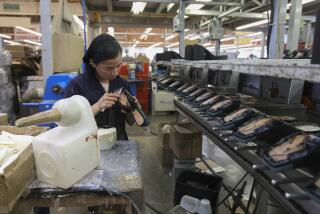Behind America’s Trade Comeback
Between the lines of the report on the U.S. trade deficit released Tuesday is the story of a resurgent American manufacturing base, surprising in its depth and diversity. The story is one of:
- A South El Monte firm that produces machines used to make powdered eggs, now finding new customers in France, China and Czechoslovakia. “We think we’re going to show a 25% (export) growth rate over the next five years annually,” said Richard M. Smith, president of Food Engineering Service.
- A West Los Angeles exporter enjoying booming overseas demand for outdoor fountains, lighting equipment and scientific instruments--unlike anything in recent memory. “I’m getting business from Europeans who wouldn’t talk to me for years,” said Charles H. Nevil, president of the Meridian Group.
- A Riverside County manufacturer of water meters and similar products experiencing growing success throughout the world. “We’ve seen a definite increase in the European market, definite increases in the Far East,” observed Fred Whorff, international products manager for McCrometer, a division of Ametek Inc., a New York-based manufacturer.
From computers to chemicals, airplanes to agricultural machinery, Tuesday’s report by the Commerce Department underscored a boom in U.S. exports that suggests the nation’s trade gap is shrinking. A key to the U.S. gains is the fall in the dollar’s value, which has made American products much more competitive than they were just a few years ago. But according to experts, the export surge arises from various factors, including an improvement in the often-maligned status of goods made in America.
“I think it’s getting fashionable to buy from America,” declared Nevil, adding that at recent exhibitions in Paris and Manchester, “European buyers who have been ignoring me for years came up to me and said, ‘Would you sell to me now?’ ”
Such anecdotes are reinforced by a growing body of evidence. The Commerce Department said Tuesday that for the first three months of 1988, exports soared 29.3% over the same period last year. From February to March, exports were up 23% to a record $28.97 billion.
In a study also released Tuesday, Bank of America reported that U.S. products were replacing foreign products both in this country and abroad more rapidly than has been recognized, and that this change had big implications for the nature of the economy’s future growth: “A major structural change is under way in the U.S. economy that is not adequately reflected in the debate over the size of the trade deficit,” bank economists wrote.
According to the bank report, U.S. exports will rise 13.8% this year, following increases of 12.8% and 3.3% in 1987 and 1986. “For California, the growth rate is likely to be higher than that because of the kinds of goods we produce here,” said Jeanette Garretty, one of the authors.
Despite the export boom, however, it would be a mistake to assume that America’s trade problems have vanished, analysts pointed out. According to the Commerce Department, imports were also higher during the first quarter of 1988 than they were in the same period last year--by a not insignificant 14.2%.
John S. Hekman, a senior economist at Claremont Economics Institute, a private consulting firm near Los Angeles, said if special items were taken into consideration, the March trade deficit fell only by $1.1 billion--not the $4.1 billion figure reported by the government. These unusual items included $1.1 billion in gold exports, much of them to Taiwan, $800 million in previous exports that had not been counted in earlier monthly reports and gyrations in the nation’s energy bill.
“There’s a lot of one-time numbers in it, but it’s very encouraging,” Hekman said of the March trade report, noting the “tremendous variation” in monthly figures because of odd factors.
Garretty agreed that it would be a mistake to pay too much attention to the March trade numbers. “It all depends whether a ship sits off the Golden Gate Bridge or comes into port on a given day,” she said of month-to-month variations. “That can jerk your numbers around a lot.”
Lower Dollar’s Benefits
Nonetheless, she said reports of U.S. export gains should be seen in the light of a variety of recent government indicators that back up the notion of heated manufacturing activity. The evidence that U.S. factories are humming briskly--with a helpful push from overseas demand--includes recent reports of unusually low unemployment and unusually high factory operating rates.
“Everything confirms that there is strong activity particularly in U.S. factories,” Garretty said.
Smith of Food Engineering Service said business is booming with the aid of the lower-valued dollar, and noted that his competition includes Danish companies who have been hurt by their own currency’s added strength relative to the greenback. “It (the lower dollar) has had a real impact--you bet,” he said of his equipment that can range in price from $700,000 to more than $1 million. “We’re making some real inroads in Europe because of that.”
At the same time, company executives say there is more to their international competitiveness than a serendipitous drop in the dollar. Whorff of McCrometer said his firm’s export gains owed more to sharply expanded marketing efforts than to currency changes.
According to Garretty of Bank of America, exports from California this year will grow by 15% to 20%--significantly outpacing the projected 13.8% national rate--because of demand for the state’s agricultural products, high tech goods and other products. California exports will be helped particularly by demand from growing Asian economies.
The lower-valued dollar “is not the whole story,” she said. “It’s the decline in the dollar combined with economic growth we see in the rest of the world.”
March ’88 March ’87 Exports Exports (millions) (millions) Ag. commodities $3,326.9 $2,416.2 Soybeans 481.5 358.3 Wheat 401.9 181.7 Animal feeds 395.6 300.6 Corn 395.4 277.5 Veg., fruit, nuts 271.6 238.5 Raw cotton 268.0 144.1 Manufactured goods 19,809.0 15,011.1 Office machinery 2,175.3 1,685.4 Electrical machinery 1,919.6 1,422.5 Airplanes 1,279.7 1,059.3 Power-gen. machinery 1,158.6 883.7 Chemicals 1,157.0 919.9 Passenger cars 899.0 584.6 Semiconductors 723.1 528.7 Aircraft parts 692.5 533.1 Scientific instruments 656.1 503.2 Telecom. equipment 555.0 414.6 Yarn, fabric 331.1 252.3 Crude materials, excluding food, fuel 1,108.0 830.8 Cork, wood, lumber 379.6 251.4 Pulp, waste paper 316.7 266.5 Metal ores, scrap 297.7 235.2 Vegetable oils 100.1 31.0 Beverages, tobacco 266.5 190.4 Cigarettes 205.5 149.9 Alcoholic beverages 12.1 6.7
Trade deficit shrinks. Part I, Page 1.
More to Read
Inside the business of entertainment
The Wide Shot brings you news, analysis and insights on everything from streaming wars to production — and what it all means for the future.
You may occasionally receive promotional content from the Los Angeles Times.










